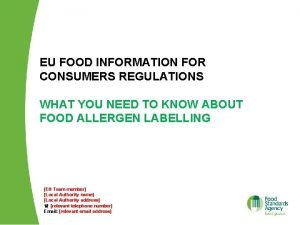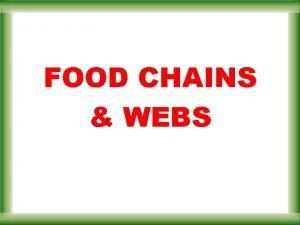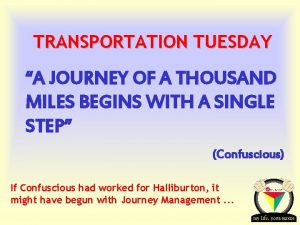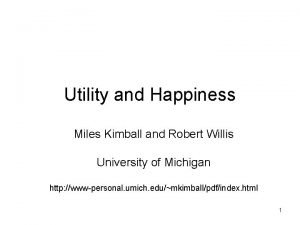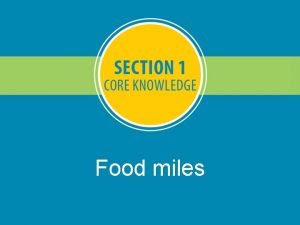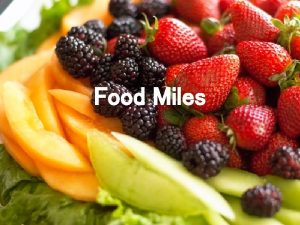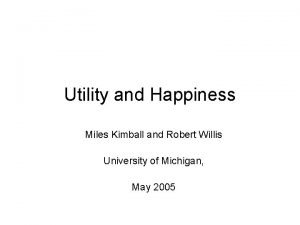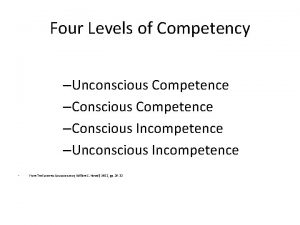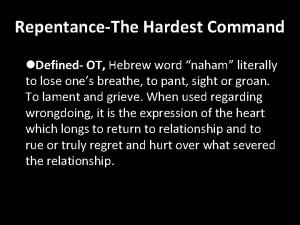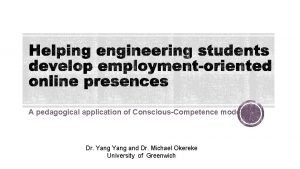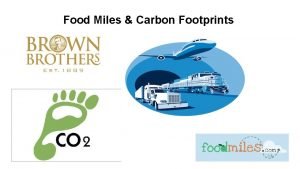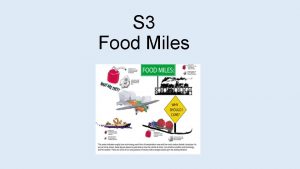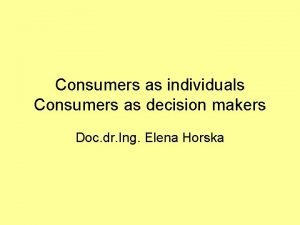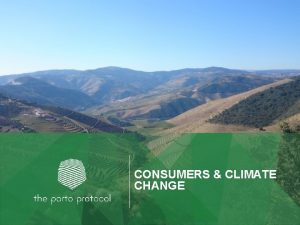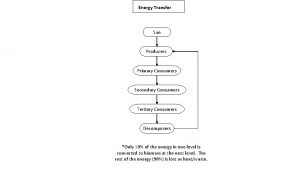CONSCIOUS CONSUMERS FOOD MILES What are food miles





























- Slides: 29

CONSCIOUS CONSUMERS

FOOD MILES

What are food miles? Food miles is the term used to describe the distance food is transported from the place its produced to the end consumer (us). The effect of food miles is measured by the amount of CO 2 emissions produced, this is usually measured per tonne of food per kilometre. Click this link to hear an Introduction to food miles with Prof Andrew Fearne For this workshop you will need: - Food miles activity sheets - Food miles ingredient cards - A calculator

What are our food miles? To explore our own food miles we are going to do activity number 1. We are going to look at the origin of the top 5 ingredients of three popular dishes and work out the food miles for each dish. The dishes we will be looking at are: Roast Dinner English Breakfast Chicken Burrito Beef Potato Carrot Onion Broccoli Eggs (free range) Tomato Baked Beans Bacon Button Mushrooms Chicken (free range) Rice Avocado Lime Peppers

Activity sheet 1 Estimated food miles 1. Choose a dish and its ingredients 2. Where do you think the ingredient is produced? - Take a guess. 3. How far has it travelled? Figure out the distance from the origin. Roast Dinner Beef Potato Carrot Onion Broccoli Ingredient Origin Miles 4. What’s the total number of miles your dishes ingredients have travelled? Total Repeat for all three dishes

How many food miles? (Example distances between some major cities and Norwich) Try this resource Egypt https: //www. foodmiles. com/results. cfm (Cairo) 2100 miles Canada (Toronto) 3500 miles China (Beijing) 5000 miles Mexico (Mexico City) 5500 miles Chile (Santiago) 7300 miles Spain (Madrid) 870 miles India (Delhi) 4100 miles Australia (Canberra) 10400 miles

Please complete activity number one

Actual meal food miles Now lets look at what the actual food miles of our dishes are. The origin of each ingredient is reported according to a leading supermarket during the winter of 2019

Roast Dinner Ingredient Beef Potato Carrot Onion Broccoli Total food miles Origin Ireland Cornwall France Netherlands Spain 1, 900 Miles 320 300 260 150 870 Low food miles due to the ingredients being produced in the UK and Europe.

English Breakfast Ingredient Origin Eggs Tomato Baked Beans Bacon Mushrooms Gloucestershire 160 Morocco 1500 Idaho, USA 4750 Denmark 400 Netherlands 150 Total food miles 6, 960 Miles Baked beans are a large contributor of food miles in this meal as the haricot beans used to make the baked beans are grown in North America, in this case Idaho.

Chicken Burrito Ingredient Chicken Rice Avocado Lime Peppers Total food miles Origin Hertfordshire India Chile Mexico Israel 19, 180 Miles 80 4100 7300 5500 2200 Lime and avocados are exotic ingredients that can not be grown in the UK so have to be imported. This has led to the high food miles of this meal.

Estimate v’s actual miles What is the difference between your estimated food miles and the actual food miles? Did you find anything surprising? Total actual food miles for all three meals: 28, 040

Cutting down on food miles - Buying Activity 2 locally There are many benefits to buying locally, it helps your local economy, the produce is often fresher, less packaging is involved and it can cut down your food miles! Going back to the dishes we bought earlier, can we buy these ingredients more locally to cut our food miles? Use the ingredient cards to see if you can source the same ingredients, more locally. Roast Dinner Ingredient Origin Miles Beef Norfolk 50 Potato Carrot Onion Broccoli Total *Note: 50 miles is allocated to produce from Norfolk to cover the miles taken to transport the ingredient from the producer to the supermarket

Please complete activity 2 Use the ingredient cards and make a note of any ingredients you choose that are in a red font!

Activity 2 Answers. - Buying locally Roast Dinner ? Ingredient Origin Miles Beef Norfolk Potato English Breakfast Ingredient Origin Miles 50 Eggs (free range) Norfolk 50 Tomato Spain 870 Carrot Norfolk 50 Baked Beans Michigan, USA 3700 Onion Norfolk 50 Bacon Norfolk 50 Broccoli Norfolk 50 Button mushrooms Netherlands 150 Total 250 Total 4820 Red font ingredients. These ingredients were not available at the supermarket where our data was collected but they can be produced locally and bought if you travel to an alternative local supermarket. Would you travel to an alternative supermarket to buy more locally grown produce, or would you buy less locally produced ingredients from your regular supermarket?

Buying Locally Combined food miles (from activity 1) 28, 040 Chicken Burrito - minus Ingredient Origin Miles Chicken (free range) Hertfordshire 80 Rice India 4100 Avocado Dominican Republic 4420 Lime Spain 870 Peppers Netherlands 150 Total 9, 620 Combined food miles (from activity 2) 14, 690 Total miles saved: 13, 350

But what does this reduction in food miles equate to?

How is our food transported? Road Transport 60% Air Transport Sea Transport Rail Transport 20% 10% *Of all food globally

CO 2 Emissions Sea Transport 10% Least CO 2 emitting form of food transport. 30 grammes per tonne of food per kilometre Road Transport Rail Transport Air Transport 10% 20% 60% More emissions are created by the drive to the supermarket to buy air freighted food than created by the air freighting www. alimentarium. org/en Most CO 2 emitting form of food transport 1500 grammes per tonne of food per kilometre

Lets calculate. . In activities 1 and 2 we looked at a selection of meals and explored how we could reduce our food miles by buying more locally produced food. Now lets look at another example in more detail. Around only 20% of all tomatoes consumed in the UK are grown here. The remaining percentage are imported from countries including South Africa and Morocco.

Calculating CO 2 emittance Activity 3 (this is worked out in kilometres instead of miles) Food origin Lancashire Morocco South Africa 120 gm/tonne/km 30 gm/tonne/km 1500 gm/tonne/km We are moving 1 tonne of tomatoes by: Which has a CO 2 footprint of: The distance being travelled is: Total CO 2 emittance for this journey is: 300 km 2166 km 9513 km Work out the total CO 2 emittance for each journey.

Activity 3 - answers Food origin Lancashire Morocco South Africa 120 gm/tonne/km 30 gm/tonne/km 1500 gm/tonne/km We are moving 1 tonne of tomatoes by: Which has a CO 2 footprint of: The distance being travelled is: 300 km Total CO 2 emittance for this journey is: 36, 000 gm 2166 km 64, 980 gm 9513 km 14, 269, 500 gm

Buying locally By buying the British grown tomatoes instead of the tomatoes imported from Morocco we could reduce our CO 2 emittance by 28, 980 gm per tonne per km. And by buying British grown tomatoes instead of tomatoes imported from South Africa, we could reduce our CO 2 emittance by 14, 233, 500 gm per tonne per km. Minimum CO 2 saving Maximum CO 2 saving 28, 980 gm 14, 233, 500 gm Per tonne.

That’s the equivalent saving in weight of Minimum Maximum 14 7, 116 Full 2 L drinks bottles (2 Kg) But is it a clear cut story? Full 2 L drinks bottles (2 Kg)

Other factors to consider… Out of season production - versus - importing Case study: Tomatoes - Tomatoes grown in the UK only produce fruit between June and November without the use of artificial heat. - It is estimated that emissions due to growing tomatoes commercially out of season in the UK and Northern Europe more widely, is between 2, 000 and 4, 000 gm CO 2 per tonne. - This is due almost entirely to the need to heat the greenhouses. - Meanwhile tomatoes from Spain and Morocco are available all year round, and these are grown using the sun’s heat, but are transported to the UK by road and/or boat. - So if you look back to the calculations from activity 3, you can see that even though the emissions from transporting tomatoes from Morocco was higher than the ones from Lancashire, if tomatoes are out of season in the UK, carbon emissions are lower by buying produce from Morocco than growing in a heated greenhouse in the UK.

Carbon Emissions Food miles in context x 7 The food sector accounts for up to 30% of all global green house gas (GHG) emissions. Transport accounts for 6% of all GHG emissions produced within the food sector. Transport Kitchen Appliances

What other miles are involved? processing Primary producer depots packaging abattoirs Can you think of any additional miles? Consumer

Other factors affecting what we buy Pricing Seasonal restrictions and availability Ethics Convenience and choice

Challenge! We hope you are feeling inspired to continue your journey through Conscious Consumerism. If so have a go at one of the following two challenges: Design communication materials to dispel common myths and help people gain a better understanding of the topic. This could be in the form of a blog, a poster, leaflets or a podcast for example. Develop a campaign to collect real data and report your findings or to encourage people or companies to change behaviours. For example, you could collect data from your school canteen to measure the food miles of the ingredients used, or you could create recipe cards to feed your gut microbes. See page 11 of the workbook for more details! These resources were produced by; Supported by; Funded by;
 Mikael ferm
Mikael ferm Producers primary consumers secondary consumers
Producers primary consumers secondary consumers What is a tertiary consumer
What is a tertiary consumer What do the arrows on a food web represent
What do the arrows on a food web represent Fsa allergy chef cards
Fsa allergy chef cards What are decomposers in a food web
What are decomposers in a food web Where are decomposers in a food web
Where are decomposers in a food web Journey of a thousand food miles
Journey of a thousand food miles Miles kimball food processor
Miles kimball food processor Food mile
Food mile Food miles.com
Food miles.com Tomato food miles
Tomato food miles Food miles list
Food miles list Miles kimball food processor
Miles kimball food processor Food miles advantages and disadvantages
Food miles advantages and disadvantages Journey of a thousand food miles
Journey of a thousand food miles Avocado food miles
Avocado food miles 700 000
700 000 Sends conscious signals through the
Sends conscious signals through the Intellectual traits
Intellectual traits Your conscious awareness of your own name and self identity
Your conscious awareness of your own name and self identity Are fish conscious
Are fish conscious 4 levels of competence
4 levels of competence Good organization and conscious repetition
Good organization and conscious repetition The good job search and conscious communication
The good job search and conscious communication Conscious bias
Conscious bias Conscious discipline breathing strategies
Conscious discipline breathing strategies Conscious decision
Conscious decision What is the conscious discipline approach?
What is the conscious discipline approach? Howell, 1982 conscious competence model
Howell, 1982 conscious competence model




